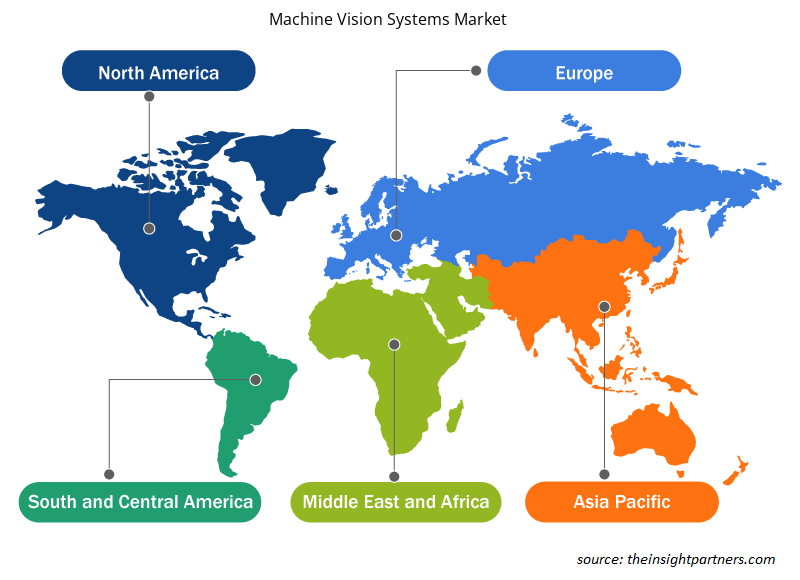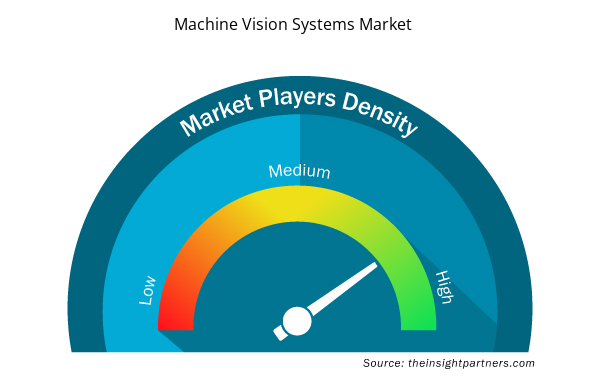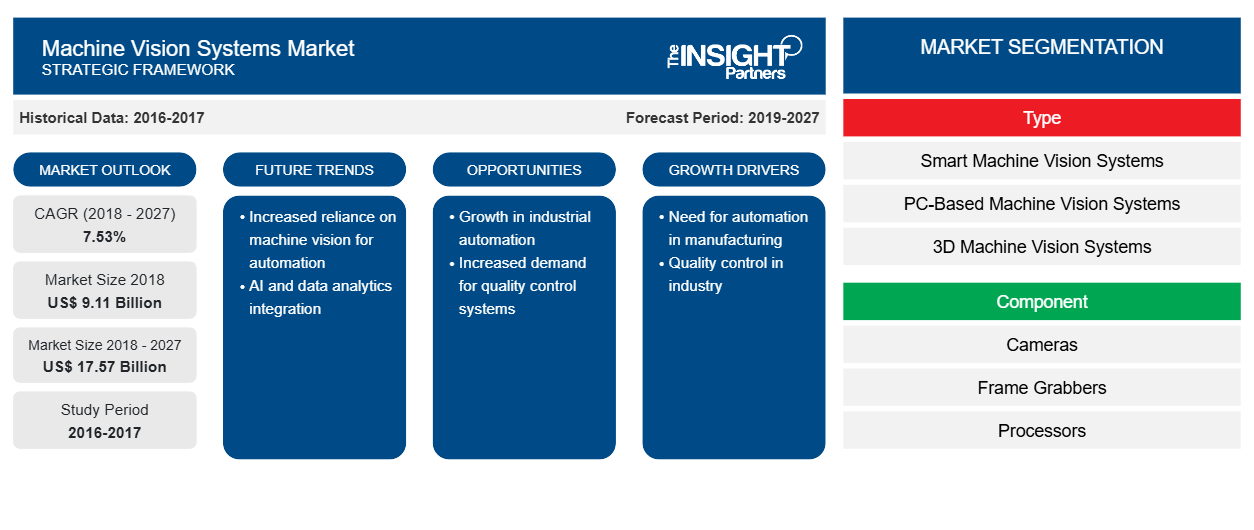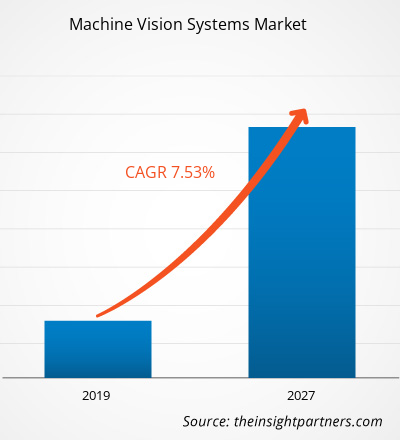2018 年机器视觉系统市场价值为 91.1 亿美元,预计到 2027 年将达到 175.7 亿美元;预计 2019 年至 2027 年的复合年增长率为 7.53%。
机器视觉系统是下一代智能系统,主要用于工业应用,用于检测、识别、测量、检查等。这些系统在机器人技术中发挥着重要作用;它们用于引导自主机器人,也称为“自导航机器人”。汽车、食品饮料、制药等各行各业都非常关注减少劳动密集型流程、提高准确性和速度;需要机器视觉系统来克服这些问题。机器视觉系统可以以更高的准确性和一致性执行复杂的重复性任务。机器视觉系统包括图像传感器、处理器、PLC、帧抓取器等组件,它们由软件包驱动以执行用户定义的应用程序。机器视觉系统还用于非检查应用,例如引导机器人、拾取和放置零件、分配液体等等。由于自动化、机器人和非制造业等行业的需求不断增加,包括智能运输系统、物流和医疗,机器视觉和组件市场预计将在未来几年经历显着增长,市场增长显著。机器视觉系统分为三种类型,即:智能视觉系统、基于 PC 的视觉系统和 3D 视觉系统。2018 年,机器视觉系统在北美创下了最高增长记录。而欧洲是全球此类系统的主要制造商和出口国。制造业是这些系统的最大终端用户,然而,由于技术的不断改进导致这些系统的成本降低,机器视觉系统在物流、智能交通系统、IP 视频监控等非工业细分应用领域的增长也在上升。
北美和欧洲总共占据了超过一半的整体市场份额,而亚太地区、中东和非洲以及南美等地区则表现出较高的增长率,这是由于技术进步和发达国家和发展中国家个人生活方式的提高等各种因素造成的。由于技术、相机和微处理器功能的不断进步、汽车和其他垂直行业倾向于实施此类解决方案,以提供更高的效率、轻松的产能扩展和优化的资本支出,预计未来几年机器视觉系统的实施将以高增长率加速。上述垂直行业中的许多小型和大型组织和企业都实施了机器视觉系统解决方案,因为它具有各种优势,从而影响了全球市场收入和增长率。发展中地区日益增长的工业化、快速的人口增长和积极的经济前景是预计推动这些地区机器视觉系统市场增长的一些主要因素。预计中国和印度等发展中国家将在预测期内为机器视觉系统市场参与者提供充足的增长机会。由于各发展中国家的政策制定者和监管机构采取了积极的举措来支持制造业和促进工业增长。中国最近的战略举措,如“中国制造 2025 计划”和印度的“印度制造”,就是此类举措的典型例子,这些举措的重点是促进这些国家的制造业和工业化。机器视觉系统市场在过去几年经历了高速增长和实施,预计未来几年也将经历显著增长。各垂直行业更多地实施机器视觉系统的主要原因之一是围绕机器视觉系统的多项相关技术的进步。计算机接口、微处理器和摄像头,所有这些工具都已发展成为功能强大且灵活的工具/组件。技术的进步促进了供应商的大规模生产和定制制造。机器视觉系统还为最终用户提供了制造过程中更高的生产力和质量,这也有助于实现更高的生产力以及更高的利润率。
定制此报告以满足您的需求
您可以免费定制任何报告,包括本报告的部分内容、国家级分析、Excel 数据包,以及为初创企业和大学提供优惠和折扣
- 获取此报告的关键市场趋势。这个免费样品将包括数据分析,从市场趋势到估计和预测。
市场洞察
全球各国政府采取措施支持制造业发展
为了实现可持续的经济发展,各国越来越注重促进工业化,特别是在制造业和加工工业领域。各国政府,尤其是印度和中国,正在通过制定法规、促进创新和知识经纪等方式采取主动行动,以实现包容性和可持续的工业化。全球制造业和加工工业快速变化的技术格局也鼓励制造公司投资于先进的系统和流程,这可以帮助实现高运营效率,并使公司能够满足当今客户的挑战性需求。本世纪的特点是所有主要垂直行业的竞争都很激烈。各种系统的制造商在成本、质量、技术、服务和上市时间等参数方面都面临着激烈的竞争。因此,为了保持市场地位并实现可持续发展,制造商越来越多地投资于先进的系统。
基于类型的市场洞察
根据类型,全球机器视觉系统市场分为智能机器视觉系统、基于 PC 的视觉系统和 3D 机器视觉系统。机器视觉系统是计算机视觉与工业制造过程的融合。机器视觉利用工业图像处理,使用放置在生产线和单元上方的摄像头,目的是在无需人工干预的情况下实时目视检查、检测产品和控制机器人。机器视觉也称为工业视觉,由多个摄像头组成,用于单独捕捉、解释和运动,并使用连接到某些预定标准的控制系统。
基于组件的市场洞察
根据组件,全球机器视觉系统市场细分为相机、图像采集器、处理器、照明和光学元件、视觉软件等。机器视觉系统不知疲倦地以 100% 的性能工作,从而提高产品质量、增加产量并降低生产成本。机器视觉系统涉及许多关键组件,例如传感器(相机)、处理器、镜头、照明和图像采集器。每个机器视觉系统都依赖于这些关键组件以获得更好的结果。组件的形式因不同类型的机器视觉系统而异。例如,基于 PC 的视觉系统需要这些组件;而智能相机视觉系统会将这些组件集成在一个模块中。机器视觉组件在部署机器视觉系统的每个行业中都发挥着至关重要的作用。
产品开发是公司扩大产品组合的常用策略。Basler AG、IDS Imaging Development Systems GmbH、Omron Microscan Systems, Inc.、COGNEX CORPORATION、Keyence Corporation、Teledyne Technologies Incorporated、Datalogic SpA、FLIR Systems, Inc.、ISRA VISION AG 和 OmniVision Technologies, Inc. 等是实施战略以扩大客户群并在全球机器视觉系统市场中获得显着份额的主要参与者,这反过来又使他们能够保持自己的品牌名称。最近的一些关键发展包括:
- 2018 年,Datalogic 在达拉斯地区的拉斯科林纳斯开设了新办事处。该办事处旨在成为北美市场的业务发展中心。新团队负责根据兴趣挖掘新线索,并将其转化为销售机会。此外,应用工程师还支持销售团队在 Datalogic 运营的所有垂直领域开展特定产品的演示活动,向潜在客户展示先进的 Datalogic 解决方案。
- 2019 年,康耐视收购了 SUALAB,以加强其在基于深度学习的机器视觉领域的领导地位。此次收购 SUALAB 的知识产权和工程团队预计将增强康耐视现有的深度学习能力,该能力基于 2017 年 4 月从 ViDi Systems 收购的技术。
机器视觉系统市场区域洞察
Insight Partners 的分析师已详细解释了预测期内影响机器视觉系统市场的区域趋势和因素。本节还讨论了北美、欧洲、亚太地区、中东和非洲以及南美和中美洲的机器视觉系统市场细分和地理位置。

- 获取机器视觉系统市场的区域特定数据
机器视觉系统市场报告范围
| 报告属性 | 细节 |
|---|---|
| 2018 年市场规模 | 91.1亿美元 |
| 2027 年市场规模 | 175.7亿美元 |
| 全球复合年增长率(2018 - 2027) | 7.53% |
| 史料 | 2016-2017 |
| 预测期 | 2019-2027 |
| 涵盖的领域 | 按类型
|
| 覆盖地区和国家 | 北美
|
| 市场领导者和主要公司简介 |
|
市场参与者密度:了解其对商业动态的影响
机器视觉系统市场正在快速增长,这得益于终端用户需求的不断增长,而这些需求又源于消费者偏好的不断变化、技术进步以及对产品优势的认识不断提高等因素。随着需求的增加,企业正在扩大其产品范围,进行创新以满足消费者的需求,并利用新兴趋势,从而进一步推动市场增长。
市场参与者密度是指在特定市场或行业内运营的企业或公司的分布情况。它表明在给定市场空间中,相对于其规模或总市场价值,有多少竞争对手(市场参与者)存在。
在机器视觉系统市场运营的主要公司有:
- 巴斯勒公司
- 康耐视公司
- 数据逻辑公司
- FLIR系统公司
- IDS 影像开发系统有限公司
免责声明:上面列出的公司没有按照任何特定顺序排列。

- 了解机器视觉系统市场主要参与者的概况
机器视觉系统市场细分:
按类型
- 智能机器视觉系统
- 基于 PC 的机器视觉系统
- 3D 机器视觉系统
按组件
- 相机
- 图像采集卡
- 处理器
- 照明与光学
- 视觉软件
- 视觉传感器
- 其他的
按接口
- USB 2.0/USB 3.0
- 相机链接
- 千兆以太网
- CoaXPress
- 其他的
按最终用户
- 汽车
- 电子及半导体
- 食品和饮料
- 药品
- 后勤
- 其他的
公司简介
- 巴斯勒公司
- IDS 影像开发系统有限公司
- 欧姆龙迈思肯系统公司
- 康耐视公司
- 基恩士公司
- Teledyne Technologies 公司
- 数据逻辑公司
- FLIR系统公司
- 伊斯拉视觉公司
- OmniVision 技术公司
- 历史分析(2 年)、基准年、预测(7 年)及复合年增长率
- PEST 和 SWOT 分析
- 市场规模价值/数量 - 全球、区域、国家
- 行业和竞争格局
- Excel 数据集



Report Coverage
Revenue forecast, Company Analysis, Industry landscape, Growth factors, and Trends

Segment Covered
This text is related
to segments covered.

Regional Scope
North America, Europe, Asia Pacific, Middle East & Africa, South & Central America

Country Scope
This text is related
to country scope.
常见问题
Presently, PC-based vision systems are the most widely used systems in the global machine vision systems market due to their high processing power and their ability to handle complex operations. In a multi-camera setup, the PC-based vision systems offer greater customizability, flexibility, and versatility in operations at a competitive price. Hence, PC-based vision systems are anticipated to drive the market growth of machine vision systems, especially in the complex and demanding applications.
Increasing adoption of Industrial Internet of Things (IIoT) for factory automation by various industries such as automotive, electronics & semiconductor, food & beverages, logistics, and pharmaceuticals is anticipated to provide ample growth opportunities for the growth of machine vision systems market during the forecast period of 2019 to 2027.
The growth of the machine vision systems market in Europe is primarily attributed to the presence of highly developed economies and a strong automotive sector in this region. The European region is one of the world’s largest producers of motor vehicles and the automotive sector is also one of the largest private sector in terms of R&D investments. Being the hub for major automotive companies, machine vision systems are extensively used in this region. Germany is the major contributor to the growth of machine vision systems in the European region.
Trends and growth analysis reports related to Electronics and Semiconductor : READ MORE..
The List of Companies
- Basler AG
- Cognex Corporation
- Datalogic S.p.A
- FLIR Systems, Inc.
- IDS Imaging Development Systems GmbH
- ISRA VISION AG
- Keyence Corporation
- OmniVision Technologies, Inc.
- Omron Microscan Systems, Inc.
- Teledyne Technologies Incorporated
The Insight Partners performs research in 4 major stages: Data Collection & Secondary Research, Primary Research, Data Analysis and Data Triangulation & Final Review.
- Data Collection and Secondary Research:
As a market research and consulting firm operating from a decade, we have published and advised several client across the globe. First step for any study will start with an assessment of currently available data and insights from existing reports. Further, historical and current market information is collected from Investor Presentations, Annual Reports, SEC Filings, etc., and other information related to company’s performance and market positioning are gathered from Paid Databases (Factiva, Hoovers, and Reuters) and various other publications available in public domain.
Several associations trade associates, technical forums, institutes, societies and organization are accessed to gain technical as well as market related insights through their publications such as research papers, blogs and press releases related to the studies are referred to get cues about the market. Further, white papers, journals, magazines, and other news articles published in last 3 years are scrutinized and analyzed to understand the current market trends.
- Primary Research:
The primarily interview analysis comprise of data obtained from industry participants interview and answers to survey questions gathered by in-house primary team.
For primary research, interviews are conducted with industry experts/CEOs/Marketing Managers/VPs/Subject Matter Experts from both demand and supply side to get a 360-degree view of the market. The primary team conducts several interviews based on the complexity of the markets to understand the various market trends and dynamics which makes research more credible and precise.
A typical research interview fulfils the following functions:
- Provides first-hand information on the market size, market trends, growth trends, competitive landscape, and outlook
- Validates and strengthens in-house secondary research findings
- Develops the analysis team’s expertise and market understanding
Primary research involves email interactions and telephone interviews for each market, category, segment, and sub-segment across geographies. The participants who typically take part in such a process include, but are not limited to:
- Industry participants: VPs, business development managers, market intelligence managers and national sales managers
- Outside experts: Valuation experts, research analysts and key opinion leaders specializing in the electronics and semiconductor industry.
Below is the breakup of our primary respondents by company, designation, and region:

Once we receive the confirmation from primary research sources or primary respondents, we finalize the base year market estimation and forecast the data as per the macroeconomic and microeconomic factors assessed during data collection.
- Data Analysis:
Once data is validated through both secondary as well as primary respondents, we finalize the market estimations by hypothesis formulation and factor analysis at regional and country level.
- Macro-Economic Factor Analysis:
We analyse macroeconomic indicators such the gross domestic product (GDP), increase in the demand for goods and services across industries, technological advancement, regional economic growth, governmental policies, the influence of COVID-19, PEST analysis, and other aspects. This analysis aids in setting benchmarks for various nations/regions and approximating market splits. Additionally, the general trend of the aforementioned components aid in determining the market's development possibilities.
- Country Level Data:
Various factors that are especially aligned to the country are taken into account to determine the market size for a certain area and country, including the presence of vendors, such as headquarters and offices, the country's GDP, demand patterns, and industry growth. To comprehend the market dynamics for the nation, a number of growth variables, inhibitors, application areas, and current market trends are researched. The aforementioned elements aid in determining the country's overall market's growth potential.
- Company Profile:
The “Table of Contents” is formulated by listing and analyzing more than 25 - 30 companies operating in the market ecosystem across geographies. However, we profile only 10 companies as a standard practice in our syndicate reports. These 10 companies comprise leading, emerging, and regional players. Nonetheless, our analysis is not restricted to the 10 listed companies, we also analyze other companies present in the market to develop a holistic view and understand the prevailing trends. The “Company Profiles” section in the report covers key facts, business description, products & services, financial information, SWOT analysis, and key developments. The financial information presented is extracted from the annual reports and official documents of the publicly listed companies. Upon collecting the information for the sections of respective companies, we verify them via various primary sources and then compile the data in respective company profiles. The company level information helps us in deriving the base number as well as in forecasting the market size.
- Developing Base Number:
Aggregation of sales statistics (2020-2022) and macro-economic factor, and other secondary and primary research insights are utilized to arrive at base number and related market shares for 2022. The data gaps are identified in this step and relevant market data is analyzed, collected from paid primary interviews or databases. On finalizing the base year market size, forecasts are developed on the basis of macro-economic, industry and market growth factors and company level analysis.
- Data Triangulation and Final Review:
The market findings and base year market size calculations are validated from supply as well as demand side. Demand side validations are based on macro-economic factor analysis and benchmarks for respective regions and countries. In case of supply side validations, revenues of major companies are estimated (in case not available) based on industry benchmark, approximate number of employees, product portfolio, and primary interviews revenues are gathered. Further revenue from target product/service segment is assessed to avoid overshooting of market statistics. In case of heavy deviations between supply and demand side values, all thes steps are repeated to achieve synchronization.
We follow an iterative model, wherein we share our research findings with Subject Matter Experts (SME’s) and Key Opinion Leaders (KOLs) until consensus view of the market is not formulated – this model negates any drastic deviation in the opinions of experts. Only validated and universally acceptable research findings are quoted in our reports.
We have important check points that we use to validate our research findings – which we call – data triangulation, where we validate the information, we generate from secondary sources with primary interviews and then we re-validate with our internal data bases and Subject matter experts. This comprehensive model enables us to deliver high quality, reliable data in shortest possible time.


 获取此报告的免费样本
获取此报告的免费样本